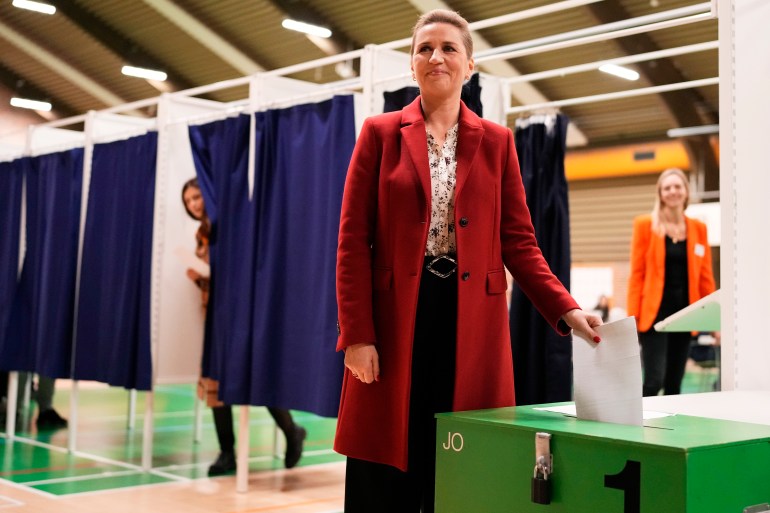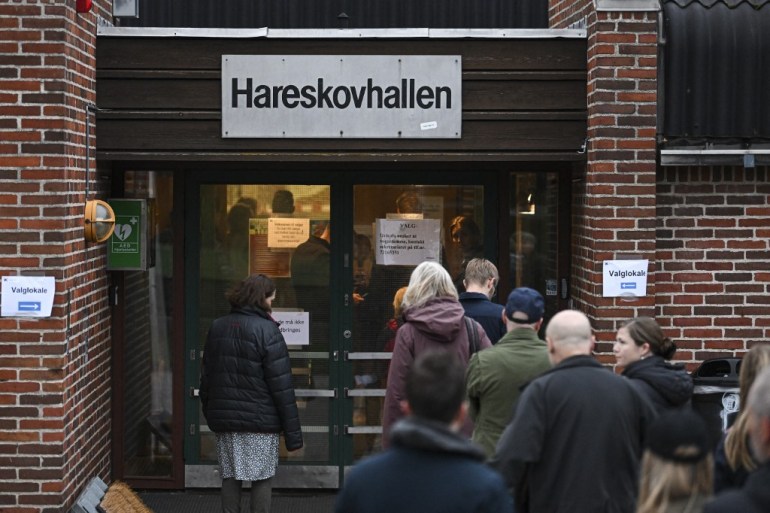No bloc wins majority in Denmark elections, exit polls show
New parties are hoping to enter parliament as polling stations open across the Scandinavian nation for a general vote.

Polling stations across Denmark have closed in a national election expected to change the Scandinavian nation’s political landscape, as the country’s former prime minister Lars Lokke Rasmussen looked set to become kingmaker.
There was no clear majority for either the governing left- or the right-wing opposition in Tuesday’s election, according to an exit poll.
Keep reading
list of 3 itemsDenmark set to keep anti-immigrant policy regardless of vote
Denmark’s prime minister calls general election for November 1
The result could – for the first time in more than four decades – pave way for a government across the traditional left-right divide.
Denmark’s centre-left parties led by Social Democratic Prime Minister Mette Frederiksen were projected to win 85 seats in the 179-seat parliament, losing its majority, an exit poll by public broadcaster DR showed after polling stations closed.
Observers had predicted earlier that neither the centre left nor the centre right would capture a majority, which is 90 seats in the Folketing legislature.
That could leave Rasmussen, who departed his party to create a new one this year, in a kingmaker position with his votes being needed to form a new government.
The election was triggered by the “mink crisis” that has embroiled Denmark since the government decided in November 2020 to cull the country’s roughly 15 million minks over fears of a mutated strain of the novel coronavirus.
The decision turned out to be illegal, however, and a party propping up Frederiksen’s minority Social Democrats government threatened to topple it unless she called elections to regain the confidence of voters.
More than four million Danish voters can choose among 14 parties. Domestic themes have dominated the campaign, ranging from tax cuts and a need to hire more nurses to financially support Danes amid inflation and soaring energy prices because of Russia’s invasion of Ukraine.
At least three politicians are vying to become prime minister.
They include Prime Minister Mette Frederiksen – who steered Denmark through the COVID-19 pandemic and teamed up with the opposition to boost Danish defence spending in the wake of Russia’s invasion of Ukraine, as well as two centre-right opposition politicians – Jakob Ellemann-Jensen, the Liberal leader, and Søren Pape Poulsen, who heads the Conservatives.

“We are fighting to the end. It will be a close election,” Frederiksen said after voting north of Copenhagen. “I am optimistic but I am not sure of anything.”
A former Liberal leader, Rasmussen created his new centrist party in June.
According to the earlier polls, his Moderates could get as much as 10 percent of the vote. He has hinted he could see a governing coalition with the Social Democrats and could also be considered a prime ministerial candidate.
On the centre right, two new parties that want to limit immigration are bidding to enter parliament and may push out a third similar group that has had a key role in earlier governments by pushing for stricter migration rules without being inside a governing coalition.
Among them are the Denmark Democrats, created in June by former hardline immigration minister Inger Støjberg.
In 2021, Støjberg was convicted by the rarely used Impeachment Court for ordering in 2016 to separate asylum-seeking couples if one of the partners was a minor.
She has served her 60-day sentence and is now eligible to run again. Pollsters have said her party could get about seven percent of the vote.
That could threaten the once-powerful populist, anti-immigration Danish People’s Party, which has been falling apart in recent months amid internal disputes and is hovering around the 2 percent threshold needed to enter parliament.
In 2015, the party grabbed 21.1 percent of the vote.

Støjberg’s party is similar to another one – the small nationalistic, anti-immigration New Right party – that is already in parliament. They have called for a broad centre-right government.
Frederiksen has been heading a minority, one-party Social Democratic government since 2019 when she removed Rasmussen.
Of the 179 seats in the Danish parliament, two come from each of Denmark’s two autonomous territories – the Faroe Islands and Greenland.
Voting was exceptionally held on Monday on the Faroes – Tuesday is a public holiday there – and one seat went to the centre left and one to the centre right in Denmark, Danish broadcaster DR said on Tuesday. Voting in Greenland is held on Tuesday.